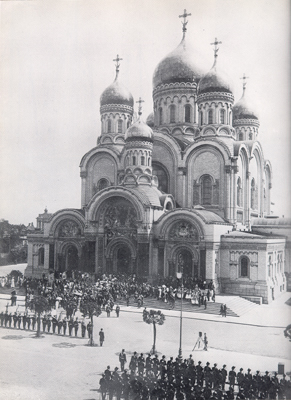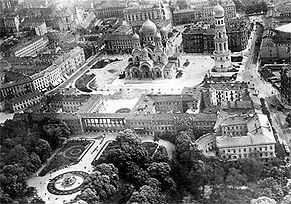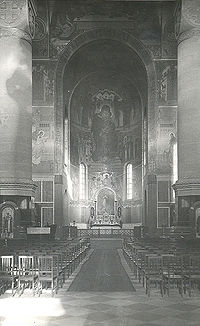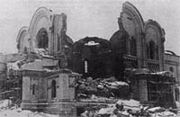
Alexander Nevsky Cathedral, Warsaw
Encyclopedia

Warsaw
Warsaw is the capital and largest city of Poland. It is located on the Vistula River, roughly from the Baltic Sea and from the Carpathian Mountains. Its population in 2010 was estimated at 1,716,855 residents with a greater metropolitan area of 2,631,902 residents, making Warsaw the 10th most...
, Poland
Poland
Poland , officially the Republic of Poland , is a country in Central Europe bordered by Germany to the west; the Czech Republic and Slovakia to the south; Ukraine, Belarus and Lithuania to the east; and the Baltic Sea and Kaliningrad Oblast, a Russian exclave, to the north...
, then under the rule of the Russian Empire. The cathedral was designed by distinguished Russian architect Leon Benois
Leon Benois
Leon Benois was a Russian architect. He was the son of architect Nicholas Benois, the brother of artists Alexandre Benois and Albert Benois, and the grandfather of the actor Sir Peter Ustinov...
, and was built between 1894 and 1912. When it was finally completed, it was 70 metres in height, at that time, the tallest building in Warsaw.
It was demolished in mid-1920s by the Polish
Second Polish Republic
The Second Polish Republic, Second Commonwealth of Poland or interwar Poland refers to Poland between the two world wars; a period in Polish history in which Poland was restored as an independent state. Officially known as the Republic of Poland or the Commonwealth of Poland , the Polish state was...
authorities less than 15 years after its construction. The negative connotations in Poland associated with Russian imperial policy towards Poland, and belief it was built purposely to hurt Polish national feelings, was cited as the major motive by the proponents of the demolition, especially since the church occupied one of Warsaw's main squares. The cathedral shared the fate of many Orthodox churches demolished after Poland regained its independence from Russia .
Background


Warsaw
Warsaw is the capital and largest city of Poland. It is located on the Vistula River, roughly from the Baltic Sea and from the Carpathian Mountains. Its population in 2010 was estimated at 1,716,855 residents with a greater metropolitan area of 2,631,902 residents, making Warsaw the 10th most...
became part of Imperial Russia in 1815, following the territorial rearrangements decided at the Congress of Vienna
Congress of Vienna
The Congress of Vienna was a conference of ambassadors of European states chaired by Klemens Wenzel von Metternich, and held in Vienna from September, 1814 to June, 1815. The objective of the Congress was to settle the many issues arising from the French Revolutionary Wars, the Napoleonic Wars,...
. The former capital of Poland - which ceased to exist in 1795 following the partitions of Poland
Partitions of Poland
The Partitions of Poland or Partitions of the Polish–Lithuanian Commonwealth took place in the second half of the 18th century and ended the existence of the Polish–Lithuanian Commonwealth, resulting in the elimination of sovereign Poland for 123 years...
- became a major administrative center in the Russian Empire
Russian Empire
The Russian Empire was a state that existed from 1721 until the Russian Revolution of 1917. It was the successor to the Tsardom of Russia and the predecessor of the Soviet Union...
, and one of its largest cities. By the second half of the 19th century, Warsaw housed a large Russian military garrison as a result of two failed uprisings against Russian rule. These developments were accompanied by a significant influx of Russian soldiers and officials into the city, most of them of the Russian Orthodox faith. Nearly 20 Russian Orthodox churches were built in Warsaw in the 1890s, primarily to accommodate the needs of the military.
The idea of building a large Orthodox
Eastern Orthodox Church
The Orthodox Church, officially called the Orthodox Catholic Church and commonly referred to as the Eastern Orthodox Church, is the second largest Christian denomination in the world, with an estimated 300 million adherents mainly in the countries of Belarus, Bulgaria, Cyprus, Georgia, Greece,...
cathedral in Warsaw was expressed in a letter from the Governor General of Poland
Poland
Poland , officially the Republic of Poland , is a country in Central Europe bordered by Germany to the west; the Czech Republic and Slovakia to the south; Ukraine, Belarus and Lithuania to the east; and the Baltic Sea and Kaliningrad Oblast, a Russian exclave, to the north...
, Joseph Vladimirovich Gourko
Joseph Vladimirovich Gourko
Count Iosif Vladimirovich Romeyko-Gurko , also known as Joseph or Ossip Gourko, was a Russian Field Marshal prominent during the Russo-Turkish War ....
, to Alexander III of Russia
Alexander III of Russia
Alexander Alexandrovich Romanov , historically remembered as Alexander III or Alexander the Peacemaker reigned as Emperor of Russia from until his death on .-Disposition:...
. He indicated that the Orthodox churches in Warsaw at that time were able to accommodate less than one tenth of the city's 42,000 Orthodox residents, who urgently needed a new place of worship.
Construction
On August 28, 1893 a special committee for the construction of the new cathedral was organized, with Gourko as its head. The committee adopted the design proposed by Leon BenoisLeon Benois
Leon Benois was a Russian architect. He was the son of architect Nicholas Benois, the brother of artists Alexandre Benois and Albert Benois, and the grandfather of the actor Sir Peter Ustinov...
and construction began in 1894. The place chosen as site of the cathedral was a monument raised by Russian authorities in memory of Polish generals who were executed in November Uprising
November Uprising
The November Uprising , Polish–Russian War 1830–31 also known as the Cadet Revolution, was an armed rebellion in the heartland of partitioned Poland against the Russian Empire. The uprising began on 29 November 1830 in Warsaw when the young Polish officers from the local Army of the Congress...
by Poles for collaborating with Russian Empire".
Tsar Alexander III gave his approval to fund the cathedral on the date of anniversary of partitions of Poland
Partitions of Poland
The Partitions of Poland or Partitions of the Polish–Lithuanian Commonwealth took place in the second half of the 18th century and ended the existence of the Polish–Lithuanian Commonwealth, resulting in the elimination of sovereign Poland for 123 years...
in 1893 which was celebrated as "joining of the West Russian state".
A significant part of the funds needed to build the cathedral were raised by personal donations from almost every corner of the Russian Empire
Russian Empire
The Russian Empire was a state that existed from 1721 until the Russian Revolution of 1917. It was the successor to the Tsardom of Russia and the predecessor of the Soviet Union...
. In an appeal to Moscow's residents, Gourko's chancellery wrote:
- "By its very presence… the Russian Church declares to the world… that in the western terrains along the VistulaVistulaThe Vistula is the longest and the most important river in Poland, at 1,047 km in length. The watershed area of the Vistula is , of which lies within Poland ....
, mighty Orthodox rule has taken root… The appearance of a new… church in Warsaw as a boundary and pillar of Orthodox Russia will animate the hopes of the Orthodox Slavs for unification under the Orthodox cross."
The rest of the funds came from mandatory donations required from all municipalities within Gourko's jurisdiction and special tax increases within the city of Warsaw http://www.sztuka.net.pl/palio/html.run?_Instance=www.sztuka.net.pl&_PageID=445&newsId=1600&_CheckSum=910386614. The mostly non-Russian-Orthodox population who had to provide these funds resented being forced to contribute, adding to the political controversy surrounding the project.
By 1900, the construction of the building was largely finished and on November 9, the Latin cross was erected on the main cupola
Cupola
In architecture, a cupola is a small, most-often dome-like, structure on top of a building. Often used to provide a lookout or to admit light and air, it usually crowns a larger roof or dome....
. At the end of the construction, the 70-meter (230 feet), bell tower
Bell tower
A bell tower is a tower which contains one or more bells, or which is designed to hold bells, even if it has none. In the European tradition, such a tower most commonly serves as part of a church and contains church bells. When attached to a city hall or other civic building, especially in...
was the tallest building in Warsaw.
Work on the interior of the cathedral, designed by Professor Nikolay Pokrovsky, continued for another 12 years. The frescoes were painted by Viktor Vasnetsov
Viktor Vasnetsov
Viktor Mikhaylovich Vasnetsov , 1848 — Moscow, July 23, 1926) was a Russian artist who specialized in mythological and historical subjects. He was described as co-founder of folklorist/romantic modernism in the Russian painting and a key figure of the revivalist movement in Russian art.- Childhood ...
. The cathedral was decorated with 16 mosaic
Mosaic
Mosaic is the art of creating images with an assemblage of small pieces of colored glass, stone, or other materials. It may be a technique of decorative art, an aspect of interior decoration, or of cultural and spiritual significance as in a cathedral...
panels designed by Vasnetsov and Andrei Ryabushkin
Andrei Ryabushkin
Andrei Petrovich Ryabushkin was a Russian painter. His major works were devoted to life of ordinary Russians of the 17th century.-Biography:...
. The decorations of the cathedral used precious and semi-precious stones extensively, marble
Marble
Marble is a metamorphic rock composed of recrystallized carbonate minerals, most commonly calcite or dolomite.Geologists use the term "marble" to refer to metamorphosed limestone; however stonemasons use the term more broadly to encompass unmetamorphosed limestone.Marble is commonly used for...
, and granite
Granite
Granite is a common and widely occurring type of intrusive, felsic, igneous rock. Granite usually has a medium- to coarse-grained texture. Occasionally some individual crystals are larger than the groundmass, in which case the texture is known as porphyritic. A granitic rock with a porphyritic...
. The altar
Altar
An altar is any structure upon which offerings such as sacrifices are made for religious purposes. Altars are usually found at shrines, and they can be located in temples, churches and other places of worship...
was decorated with jasper
Jasper
Jasper, a form of chalcedony, is an opaque, impure variety of silica, usually red, yellow, brown or green in color; and rarely blue. This mineral breaks with a smooth surface, and is used for ornamentation or as a gemstone. It can be highly polished and is used for vases, seals, and at one time for...
columns. The largest of the 14 bells was the fifth-largest in the empire.
On May 20, 1912 the ceremonial dedication of the Cathedral to Alexander Nevsky
Alexander Nevsky
Alexander Nevsky was the Prince of Novgorod and Grand Prince of Vladimir during some of the most trying times in the city's history. Commonly regarded as the key figure of medieval Rus, Alexander was the grandson of Vsevolod the Big Nest and rose to legendary status on account of his military...
was held, where Archbishop Nicholas of Warsaw said:
- "The creators of this cathedral had nothing hostile in their thoughts towards the unorthodoxy that surrounds us: coercion is not in the nature of the Eastern Orthodox Church".
Demolition

World War I
World War I , which was predominantly called the World War or the Great War from its occurrence until 1939, and the First World War or World War I thereafter, was a major war centred in Europe that began on 28 July 1914 and lasted until 11 November 1918...
, the Russians evacuated Warsaw in August 1915. They took with them most of the Orthodox inhabitants and clergy, as well as many precious works of art from the cathedral. During the German occupation in 1915–1918 the cathedral was used by the German military as a garrison church and renamed for St Henry
Henry II, Holy Roman Emperor
Henry II , also referred to as Saint Henry, Obl.S.B., was the fifth and last Holy Roman Emperor of the Ottonian dynasty, from his coronation in Rome in 1014 until his death a decade later. He was crowned King of the Germans in 1002 and King of Italy in 1004...
. They appropriated the valuable copper roof, towards their war effort, leading to increasing water damage inside the church. They also made some alterations to the cathedral to suit their needs, such as adding a pipe organ
Pipe organ
The pipe organ is a musical instrument that produces sound by driving pressurized air through pipes selected via a keyboard. Because each organ pipe produces a single pitch, the pipes are provided in sets called ranks, each of which has a common timbre and volume throughout the keyboard compass...
and chairs for the worshippers, as a rule not found in Orthodox churches.
After Poland regained its independence in 1918, the fate of the cathedral was the subject of an intense debate for a number of years. It was perceived by the Polish inhabitants of Warsaw as a symbol of Russian domination and hence was very unpopular, and while some considered it a great work of architecture that should be preserved, the Stefan Batory University
Vilnius University
Vilnius University is the oldest university in the Baltic states and one of the oldest in Eastern Europe. It is also the largest university in Lithuania....
Arts Faculty estimated it as having little artistic value.http://www.sztuka.net.pl/palio/html.run?_Instance=www.sztuka.net.pl&_PageID=445&newsId=1600&_CheckSum=910386614
There were proposals to make it into a Catholic church. Among other proposals, the famous Polish writer Stefan Żeromski
Stefan Zeromski
Stefan Żeromski was a Polish novelist and dramatist. He was called the "conscience of Polish literature". He also wrote under the pen names: Maurycy Zych, Józef Katerla and Stefan Iksmoreż.- Life :...
argued that the Cathedral might be the best place for the Museum of the Martyrology
Martyrology
A martyrology is a catalogue or list of martyrs , arranged in the calendar order of their anniversaries or feasts. Local martyrologies record exclusively the custom of a particular Church. Local lists were enriched by names borrowed from neighbouring churches...
of Polish people. Others argued on more utilitarian grounds that a church constructed as recently as 1912, and taking up valuable space in one of Warsaw's main squares, was not a significant enough work of architecture to be preserved, given that most of the Russian Orthodox believers had left the city when Russian rule ended.
In the end, despite a few protests, it was demolished in 1924–1926, along with all but two Orthodox churches in Warsaw. Adding to the political and nation-wide character to the destruction of the largest Orthodox Cathedral in interwar Poland, the Warsaw magistrate issued public bonds to "give a chance to every Pole to take part in the action." The bonds were backed by the value of the materials recovered during demolition.
Occasional attempts to save the cathedral continued even while demolition was underway. For example, in the summer of 1924 an Orthodox member of the Polish Senate, Vyacheslav Bogdanovich, gave a passionate speech in favour of preserving the cathedral. However, overall such voices were few and far between. The proponents of its preservation in its original form were contemptuously called the "Cathedralists", thus implicitly accusing them of an underlying lack of patriotism.
The demolition itself was complex, and required almost 15,000 controlled explosions. Much of the high quality marble obtained during the demolition was reused in the decoration of various Warsaw buildings. The mosaics were carefully disassembled and some of them taken to the Orthodox cathedral in Baranowicze (Baranavichy).http://globus.tut.by/baranovich/index.htm After many years of storage in the National Museum in Warsaw
National Museum in Warsaw
The National Museum in Warsaw , Poland, is a national institution of culture, one of the largest museums in Poland and the largest in Warsaw. It comprise a rich collection of ancient art , counting about 11.000 pieces, an extensive gallery of Polish painting since the 16th century and a collection...
, other fragments were installed in the Mary Magdalene Orthodox Cathedral in the Warsaw suburb of Praga
Praga
Praga is a historical borough of Warsaw, the capital of Poland. It is located on the east bank of the river Vistula. First mentioned in 1432, until 1791 it formed a separate town with its own city charter.- History :...
.
See also
- Alexander NevskyAlexander NevskyAlexander Nevsky was the Prince of Novgorod and Grand Prince of Vladimir during some of the most trying times in the city's history. Commonly regarded as the key figure of medieval Rus, Alexander was the grandson of Vsevolod the Big Nest and rose to legendary status on account of his military...
- Other Alexander Nevsky CathedralAlexander Nevsky CathedralAlexander Nevsky Cathedral may refer to various Eastern Orthodox cathedrals, all named after Russian saint Alexander Nevsky:* Alexander Nevsky Cathedral, Baku in Azerbaijan * Alexander Nevsky Cathedral, Belgrade in Serbia...
s - Field Cathedral of the Polish ArmyField Cathedral of the Polish ArmyThe Field Cathedral of the Polish Army is the main garrison church of Warsaw and the representative cathedral of the entire Polish Army. In the past the church served a variety of communities and roles: it used to be the church of the Collegium Nobilium and in the 19th century was also turned into...
, another cathedral in Warsaw that used to be an Orthodox church - Warsaw Palace of Culture and ScienceWarsaw Palace of Culture and ScienceThe Palace of Culture and Science in Warsaw is the tallest building in Poland, the eighth tallest building in the European Union. The building was originally known as the Joseph Stalin Palace of Culture and Science , but in the wake of destalinization the dedication to Stalin was revoked; Stalin's...
, a monumental building in central Warsaw, constructed by the Soviet UnionSoviet UnionThe Soviet Union , officially the Union of Soviet Socialist Republics , was a constitutionally socialist state that existed in Eurasia between 1922 and 1991....
in Communist Poland. - Japanese General Government Building, SeoulJapanese General Government Building, SeoulThe Japanese Government-General Building was the chief administrative building in Keijo during the Japanese colonial rule of Korea and the seat of the Governor-General of Korea. It was a neo-classical building designed by German architect Georg De Lalande, and was completed in 1926...
- Palast der RepublikPalast der RepublikThe Palace of the Republic in Berlin was the seat of the parliament of the German Democratic Republic, the People's Chamber, and also served various cultural purposes...
- St. Florian's CathedralSt. Florian's CathedralSt. Florian's Cathedral, more formally known as the Cathedral of St. Michael the Archangel and St. Florian the Martyr , is a Catholic church and historical landmark at ul. Floriańska 3 in eastern Warsaw. The 75-meter towers of St...

